Buffalo AirStation Nfiniti – Draft-n Router Review
Buffalo AirStation Nfiniti – Draft-n Router
With 802.11n taking an age to get ratified, should you be considering draft-n products?
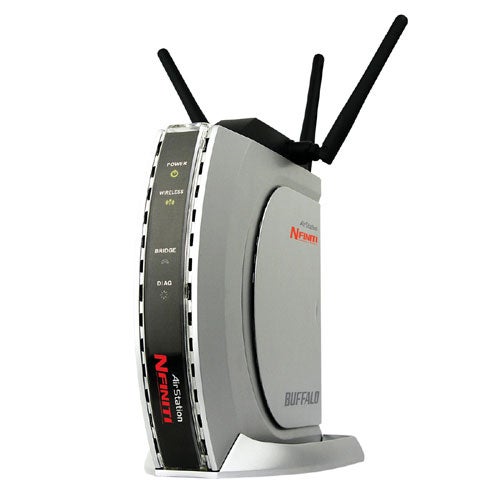
Verdict
Key Specifications
- Review Price: £129.25
There’s no doubt that the 802.11n standard has caused more controversy than any other wireless specification. Originally put forward for informal investigation way, way back in 2003 there have since been massive arguments which culminated in May this year with the first working draft being unceremoniously dumped when a sponsor ballot returned less than half the votes in favour of it. To become a final draft with the potential to make it through to ratification it needed at least 75 per cent of the votes.
Nevertheless, this hasn’t stopped the inevitable rush of so-called draft-n products and Buffalo Technology claims a first to market in the UK with its AirStation Nfiniti product family. These use the latest Broadcom Intensi-fi chip which has been designed to cater particularly to the demands for video, voice and music over high-speed wireless networks. It employs a number of technologies and along with MIMO (multiple in multiple out) it is capable of using multiple channels to transmit two streams of data. Called spatial streams, these each comprise 20MHz channels which can be bonded together to create a 40MHz pipeline.

This sounds great except that the 2.4GHz band has room for three non-overlapping channels so with the Nfiniti blasting away at top speed it doesn’t leave much room for many other devices to transmit. The Intensi-fi chip aims to overcome this with intelligent dynamic management which Broadcom coins its ‘good neighbour’ mode. Essentially, if the Nfiniti detects other devices such as legacy products trying to transmit in its vicinity it will drop back to 20MHz channels to create some wireless space for them. Performance claims are impressive with 300Mbit/sec being quoted for dual channel products and an amazing 600Mbps for the proposed quad spatial streams which will presumably operate in the 5GHz band.
And so to the Nfiniti router, which is an unassuming slab of plastic topped of with three adjustable, but non-removable, aerials. You get the standard quad of Fast Ethernet LAN ports at the back while the WAN connection is handled by a fifth Fast Ethernet port, meaning that the unit can accept external cable or ADSL modems. The web interface is common to most of Buffalo’s wireless routers and opens with a quick access page to common settings including port mapping, the SPI firewall, intrusion detection, wireless security and an Internet access wizard. The Advanced option provides full access to all LAN, WAN and wireless parameters and administration and diagnostics pages. The wireless setup page now has a few extra goodies as you can elect to use 20MHz channels, go for the full 40Mhz channel bonding and opt for using channels at the lower or upper end of the 2.4GHz spectrum.
No doubt the burning question is does the Nfiniti live up to the performance claims? And unfortunately the answer is no. We conducted testing in a residential environment and installed the Nfiniti PC Card in a 1.6GHz Fujitsu Siemens notebook running Windows XP SP2. Using the open source Iometer we wirelessly linked the laptop with a Supermicro Pentium D 3.2GHz on the LAN and with no encryption over a two metre line of sight connection it reported an average raw read throughput of 75Mbit/sec. With an AOSS negotiated WPA-TKIP encrypted connection we saw Iometer report a more modest 51Mbit/sec.
For real world performance we saw a 691MB video file copied from the laptop to the PC in 100 seconds for an average speed of 55Mbit/sec over an open link and 46Mbit/sec with WPA encryption in force. Extending the range had some dramatic effects. We moved the laptop to the floor below which also put a couple of brick walls in the way and we watched throughput level out at only 28Mbit/sec for an open link.
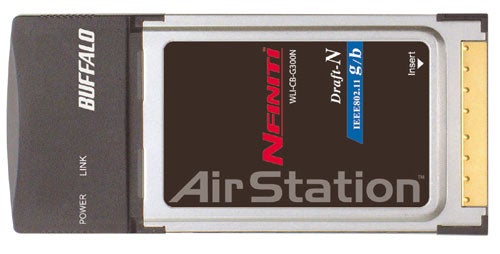
To test for compatibility we used a Linksys Wireless-G ADSL Gateway and Wireless-G PC Card. Buffalo’s client had no problems working with the Linksys card and we achieved a 100 per cent connection success rate with the Nfiniti router. However, performance wasn’t overly impressive with Iometer reporting a measly 22Mbit/sec raw throughput at close range over an open connection. The Nfiniti card also connected successfully with the Linksys gateway but once again speed wasn’t impressive with it churning out a modest 24Mbitsec.
When it comes to making a recommendation there are already massively conflicting views about whether these so-called draft-n products are a safe bet. First, we were advised by Buffalo that no company offering these products will guarantee they can be upgraded to standard-based 802.11n operations. This isn’t surprising as if they did so it would be tantamount to a commitment to replace the product if it couldn’t be upgraded. Broadcom has said that its Intensi-Fi is the ‘softest’ radio chip it has yet manufactured so upgrading it should be easy although this, of course, remains to be seen.
”’Verdict”’
The first draft-n wireless products deliver a significant boost in overall performance but not as much as the manufacturers would have you believe. Range is no better than standard MIMO routers so only buy the Nfiniti products if you feel the need for speed and are prepared to take a big risk with regard to future upgrades. Remember that ratification of an 802.11n standard is probably at least a year away and could change significantly from what you have here.
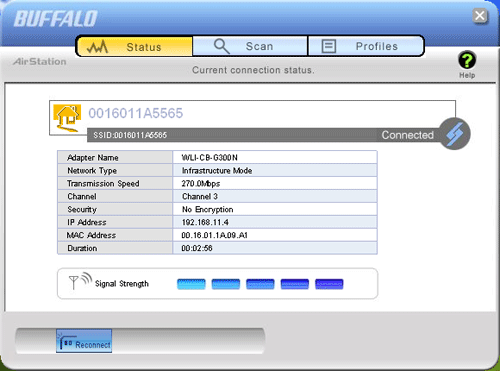
The Client Manager makes light work of wireless connection but don’t be fooled by the speed being displayed.
—-
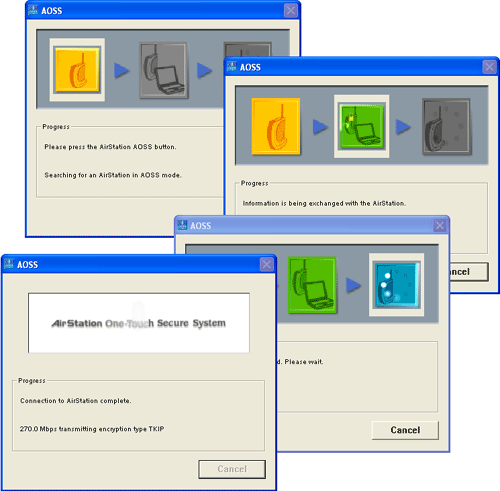
If you want a fully encrypted wireless connection at the press of a button than call up Buffalo’s AOSS.
—-
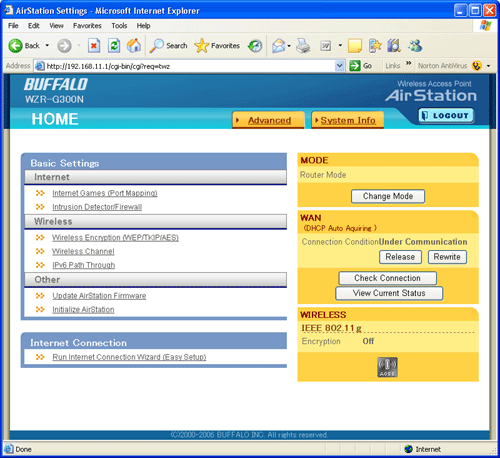
The browser home page provides quick access to features such as port mapping and wireless security.
—-
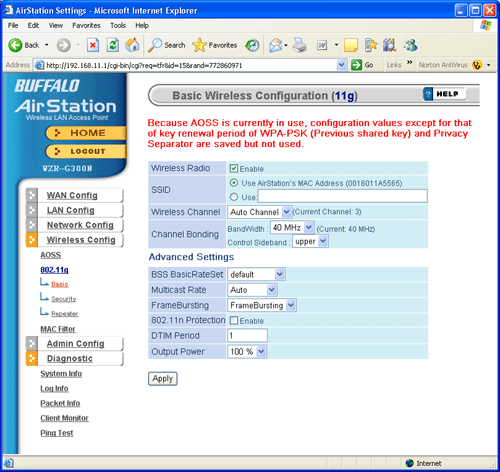
The wireless settings page reveals the new high speed settings for spatial streams.
—-
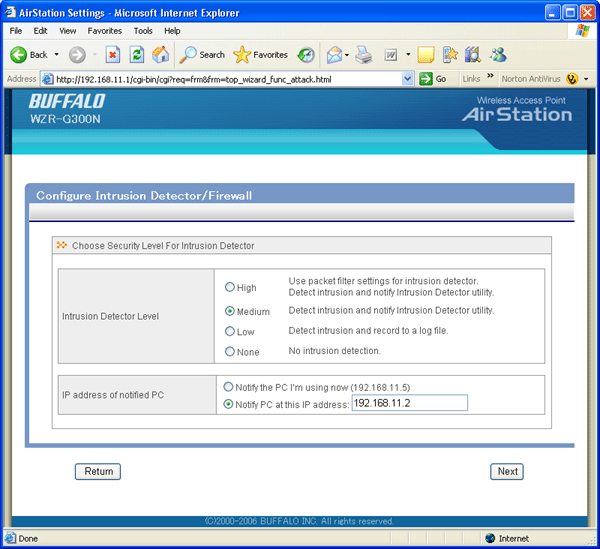
Along with firewall protection you can add intrusion detection and notification to systems running the Client Manager.
—-

